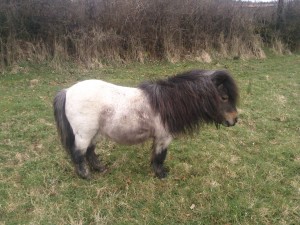Goldsytch Shetland Pony Stud Update August 2011: New Ponies
 I’m pleased to announce that the Goldsytch Miniature Shetland Pony will be growing in terms of pony numbers.
I’m pleased to announce that the Goldsytch Miniature Shetland Pony will be growing in terms of pony numbers.
Currently our herd consists of:
Goldsytch Gradbach (29″ red roan stallion)
Morjoy Tulip (31″ bay mare)
For a while now we’ve been looking to get a new mare (to celebrate my birthday last January) and have found a lovely chestnut roan mare called Hermits Velvet Rose (Rosie).
On Saturday 30th July 2011 we visited the Mignon Shetland pony stud and saw Rosie for the first time, although we had had photos f her, and absolutely fell in live with her. She’s a beautiful mare with excellent confirmation.
Rosie has a foal! Her 2011 foal Mignon Velvet was born in may and will be coming to live with us, though will be still be owned by the Mignon stud, until September when he can be weaned. So, I’ll be training him. I have also decided to temporarily rename him ‘Victor’ as we already have a ‘Velvet’ at our farm (my rabbit!).
Hermits Velvet Rose has had three foals – all of which have been colts – and we will be running her with our roan stallion Gradbach for a 2012 foal (yes it will be a late foal).
Initially we were a little worried about breeding Gradbach and Rosie together due to them both being roan ponies and the worry of the lethal roan gene. After a lot of research (and a very helpful US roan ranch owner), and talking to my parents who used to run the Goldsytch stud,В I’ve come to the conclusion that no lethal gene would be produced in this case. For a lethal gene to be produced you have to breed homozygous roan with a homozygous roan. Seeing as Gradbach’s parents were roan and grey it is highly unlikely that he’s homozygous roan – he’s most likely heterozygous roan. We also believe that Rosie us heterozygous roan as only one of her parents was roan.
If Rosie and Gradbach had a roan foal, there’s a possibility that that foal would be homozygous roan (inheriting both roan genes from the parents). If that was the case the foal shouldn’t be bred to another homozygous roan. Yet the foal could be heterozygous roan (having inherited only one roan gene from one parent, and a different colour from another -e.g grey from Gradbach and roan from Rosie) in which case there shouldn’t be a problem breeding it to a roan pony.
From what research I’ve gathered about the lethal roan gene I understand that it isn’t a big problem. And some experts say that it doesn’t exist. Most studies have shown that where the lethal gene has been produced the embryo has been absorbed back into the mare’s womb before the owner likely knew she was in foal. If the foal was born it is believed it wouldn’t survive for long, yet it is unlikely that it would develop that much.В Yet there are some ponies, stallions in particular, that are believed to have both homozygous roan parents and these ponies have survived ‘foalhood’ and are perfectly healthy. So it unclear as to whether this lethal gene is really a problem when it is produced after all.
Hermits Velvet Rose and her foal will he delivered to our farm this Friday (5th August).
 August 4, 2011
В·
August 4, 2011
В·  Maddia (Admin) В·
Maddia (Admin) В·  Comments Closed
Comments Closed
 Tags: breeding roan ponies, breeding shetlands, goldsytch gradbach, hermits velvet rose, mignon velvet, morjoy tulip, shetland ponies В· Posted in: Goldsytch Miniature Shetland Ponies, My Pet Updates, My Shetland Ponies
Tags: breeding roan ponies, breeding shetlands, goldsytch gradbach, hermits velvet rose, mignon velvet, morjoy tulip, shetland ponies В· Posted in: Goldsytch Miniature Shetland Ponies, My Pet Updates, My Shetland Ponies


